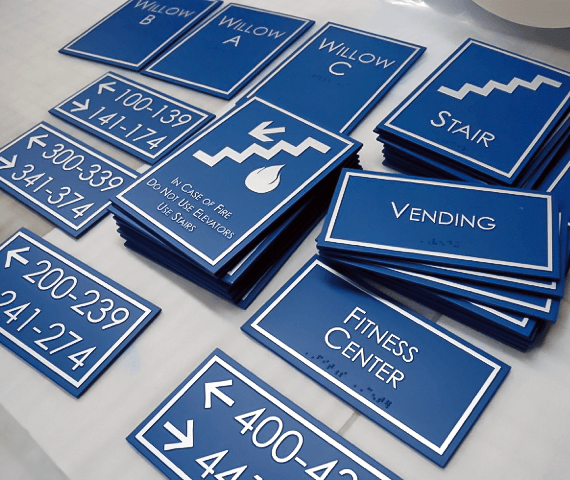The Influence of ADA Signs on Area Access
ADA Signs: Making Sure Accessibility and Compliance in Public Spaces
ADA signage plays a crucial role in guaranteeing ease of access and compliance within public areas, dramatically adding to a comprehensive environment for individuals with impairments. As we explore the nuances of ADA signs, from responsive attributes to make details, it's crucial to consider how these elements coalesce to support the legal rights of all individuals.
Value of ADA Signs
In contemporary culture, the importance of ADA signage prolongs past simple conformity with legal mandates to personify a dedication to inclusivity and availability for all individuals. These signs are necessary in producing atmospheres where individuals with specials needs can navigate public rooms with the same simplicity and independence as those without disabilities. By providing standard and clear information, ADA signs makes certain that everybody can access facilities, solutions, and info without barriers.
The relevance of ADA signs hinges on its capacity to improve the quality of life for individuals with specials needs by promoting equivalent gain access to. It eliminates the barriers that might or else impede their ability to get involved fully in area life. Moreover, these signs function as visible indicators of an organization's commitment to diversity and equality, mirroring wider social values that promote the legal rights and self-respect of all individuals.
Moreover, ADA signage plays an essential function in public safety. By directing people to exits, bathrooms, and various other important centers, it ensures that all people, no matter of physical ability, can evacuate securely throughout emergency situations. In summary, ADA signage is not simply a governing requirement however an effective device for fostering a equitable and inclusive culture.
Crucial Element of Compliance

Positioning is important; indications must be mounted in locations that are reachable and quickly noticeable. Typically, signage should be placed between 48 and 60 inches from the ground to ensure ease of access for both standing and wheelchair customers. Responsive components, such as Braille, are necessary for people with aesthetic impairments, offering vital info in a non-visual layout.
High-contrast shades between the message and history are needed to boost readability for people with reduced vision. The ADA mandates particular comparison proportions to make sure clearness. In addition, character dimension is a vital factor to consider, with minimum height demands determined by the seeing range to guarantee readability from numerous angles.
Style Considerations for Access
Designing accessible signage needs a meticulous method to ensure it meets the demands of all individuals, specifically those with handicaps. The dimension of the text is similarly vital, with ADA guidelines advising a minimum height based on checking out range to ensure clarity.
Contrasting shades between message and history are crucial for visibility, especially for individuals with visual disabilities. In addition, tactile aspects, such as Braille and increased personalities, are vital for individuals who are blind or have low vision.
In addition, the placement of signs plays a substantial duty in accessibility. Indicators must be mounted in locations that are easily obtainable and unblocked. Ensuring that signs is placed at ideal elevations and angles makes it possible for all customers, including those utilizing wheelchairs, to communicate with them effectively.
Common Errors to Stay Clear Of

An additional common error is the inaccurate placement of signs. ADA guidelines define precise height and area needs to make certain that indications are reachable and conveniently noticeable by all individuals, including those making use of mobility devices. Disregarding these standards her comment is here not just hinders click to investigate ease of access however additionally risks non-compliance with lawful standards.
In addition, insufficient comparison between message and history is a constant oversight. Adequate contrast is vital for readability, especially for individuals with reduced vision. Developers often choose colors that are visually enticing however do not have the essential contrast, making the message difficult to discern.
Lastly, some developers fail to incorporate tactile aspects, such as Braille, which are essential for people who are blind. Leaving out these features not only leads to non-compliance with ADA regulations however additionally limits access for a section of the population that depends on tactile details.
Future Trends in Signs
Innovations in modern technology and boosting understanding of inclusivity are shaping the future fads in signs design. Digital signage, for circumstances, is progressing to include interactive features and real-time updates, which can be critical in giving dynamic information in public spaces.
One more emerging pattern is the usage of increased truth (AR) to enhance individual experience. AR-enabled signs can overlay electronic information onto the physical setting, offering aesthetically impaired individuals with auditory or haptic responses. ADA Signs. This innovation not just improves access but additionally creates an appealing experience for all customers
Sustainability is likewise a substantial factor affecting signs trends. Green materials and energy-efficient illumination remedies are being prioritized to align with worldwide ecological goals. Developments in products scientific research are leading to the growth of more resilient and weather-resistant indicators.
Verdict
ADA signage plays an important function in ensuring availability and conformity within public rooms by including responsive elements, high-contrast colors, and strategic placement. The adherence to ADA standards not only helps with risk-free navigating for people with disabilities but also represents an organization's commitment to variety and inclusivity. By staying clear of typical errors and accepting future patterns, public areas can proceed to advance these values, making sure that the civil liberties and self-respect of all people are valued and promoted.
ADA signs plays an essential role in assuring accessibility and conformity try here within public rooms, dramatically adding to an inclusive atmosphere for people with disabilities. As we explore the subtleties of ADA signage, from tactile functions to develop details, it's important to consider how these aspects coalesce to maintain the rights of all individuals.In contemporary society, the importance of ADA signs prolongs past simple compliance with lawful requireds to embody a dedication to inclusivity and accessibility for all individuals. By supplying clear and standard information, ADA signs makes sure that everybody can access facilities, solutions, and details without barriers.
ADA signs plays a crucial duty in ensuring ease of access and conformity within public spaces by incorporating tactile components, high-contrast shades, and tactical positioning. (ADA Signs)